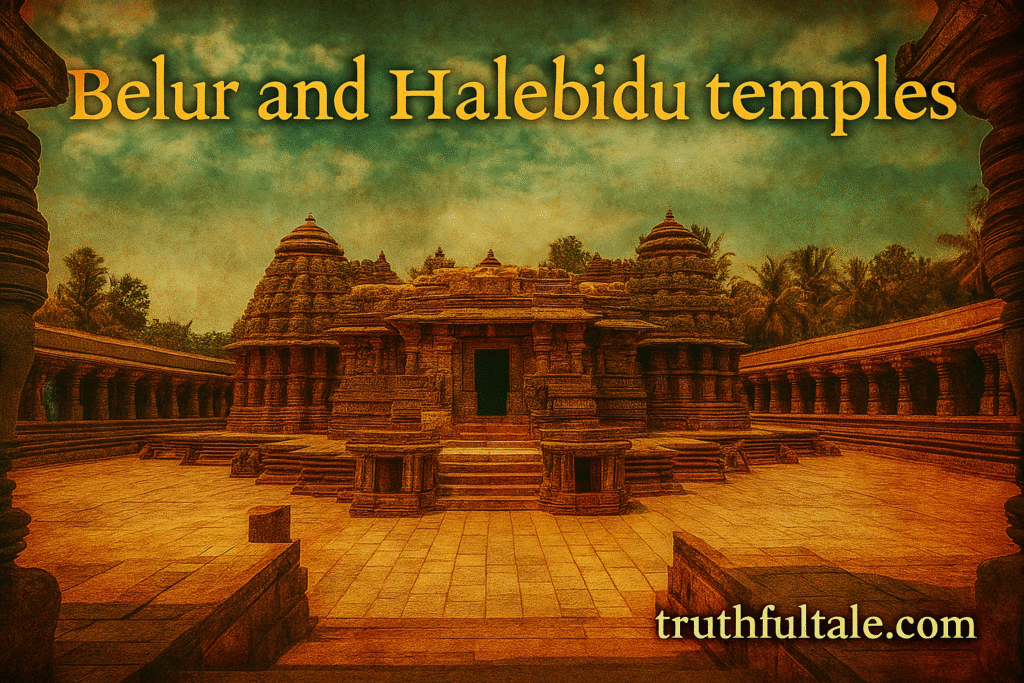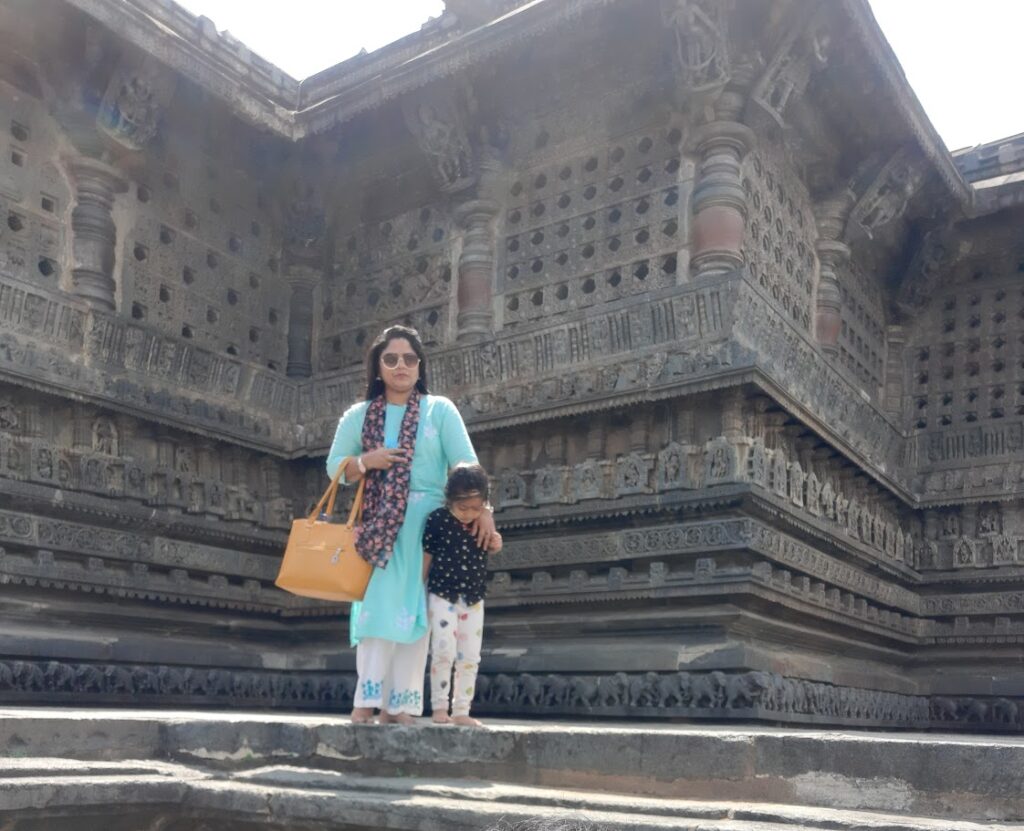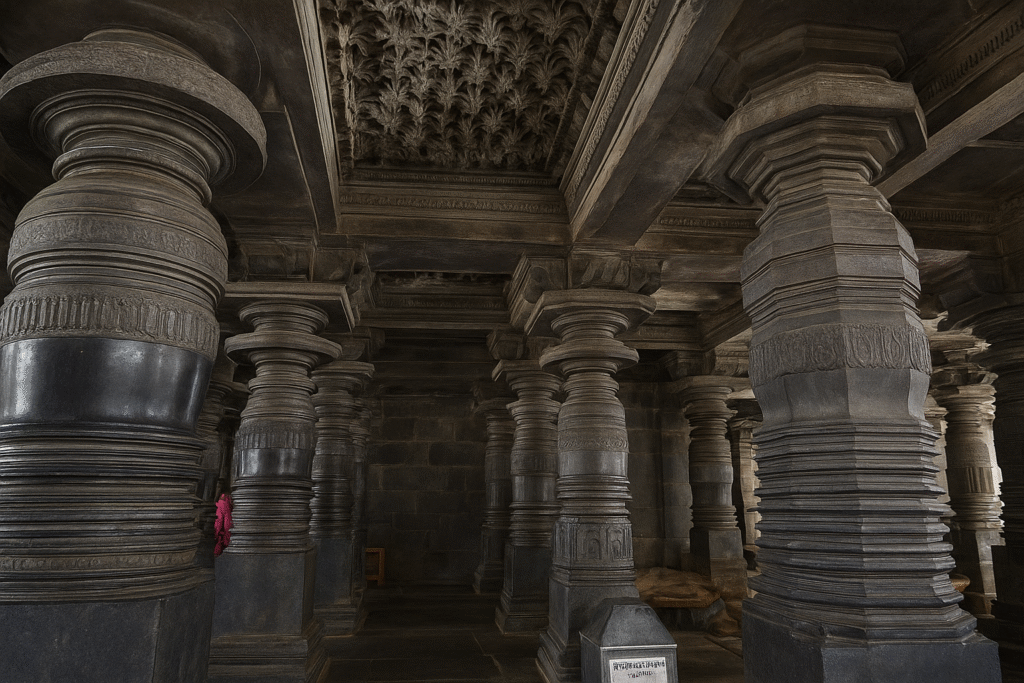Belur and Halebidu Temples: Stories Carved in Stone

Nestled in the heart of Karnataka, the temples of Belur and Halebidu stand as living masterpieces of Hoysala architecture. Known for their intricate carvings, unique star-shaped platforms, and mythological sculptures, these temples are not just places of worship but also chronicles of history, faith, and artistry. The crown jewel among them is the Chennakeshava Temple of Belur, dedicated to Lord Vishnu, which reflects both spiritual devotion and unmatched craftsmanship.
History of Belur and Halebidu Temples
The Hoysala dynasty (10th–14th century) ruled much of present-day Karnataka and became renowned patrons of temple art. King Vishnuvardhana commissioned the Chennakeshava Temple in Belur in 1117 CE to celebrate his victory over the Cholas at Talakad and his conversion from Jainism to Vaishnavism under the influence of Guru Ramanujacharya.
Halebidu, originally called Dwarasamudra, was the imperial capital of the Hoysalas. The temples here, especially the Hoysaleswara Temple dedicated to Lord Shiva, were built in the 12th century but suffered destruction during repeated invasions by the Delhi Sultanate in the 14th century. Despite this, the ruins still echo their former glory.
The Chennakeshava Temple, Belur

Dedicated to Lord Vishnu in the form of Chennakeshava (literally “handsome Keshava”), this temple is the most celebrated monument of the Hoysalas. Construction began in 1117 CE under King Vishnuvardhana and continued for more than a century, with successive rulers and artisans adding to its grandeur.
Built on a raised jagati (platform), the temple is shaped like a star, a unique feature of Hoysala architecture. This design not only gives the temple an extraordinary appearance but also allows devotees to perform pradakshina (circumambulation) around the shrine while admiring the carvings.
The temple’s walls are adorned with thousands of sculptures, each telling a story from Hindu epics and Puranas. The avatars of Vishnu, episodes from the Ramayana, Mahabharata, and Bhagavata Purana, as well as depictions of daily life, musicians, and dancers, create a living museum carved in stone.
Garuda – The Vehicle of Lord Vishnu
A striking feature of the temple complex is the Garuda Stambha (pillar) placed in front of the shrine. Garuda, the eagle mount of Vishnu, is usually depicted as a bird-like figure with wings. However, in Belur, the Hoysala sculptors portrayed Garuda in a rare human-like form, standing tall with folded hands, facing his Lord with utmost devotion.
This form is called “Anthropomorphic Garuda”, where the divine bird is shown with human features, wearing ornaments and standing in a posture of reverence.
His folded hands symbolize complete surrender (sharanagati) to Lord Vishnu, reflecting the essence of Vaishnavism.
The placement of Garuda directly in front of the sanctum signifies that even the divine mount awaits the Lord’s command with humility, setting an example for devotees.
According to legends, Garuda requested Vishnu to allow him to remain in eternal service outside the temple, watching over his Lord and protecting the sanctum.
This Garuda image is considered unique to Hoysala architecture, as most other depictions across India show Garuda in a more birdlike or warrior form. The Belur Garuda thus stands as a rare spiritual and artistic masterpiece.
Pillars and Sculptures of the Main Shrine

One of the most striking features of Belur and Halebidu temples is their lathe-turned pillars—smooth, polished, and geometrically perfect. Among these, the Narasimha pillar in the Chennakeshava Temple is especially famous; it was once said to rotate on its base.
The outer walls are adorned with sculptures of gods, goddesses, animals, celestial beings, dancers, and mythological episodes from the Ramayana, Mahabharata, and Bhagavata Purana. Each sculpture narrates a story—from Lord Vishnu’s avatars to scenes of divine love and war. The attention to detail is so precise that even the jewelry, hairstyles, and expressions are carved with lifelike beauty.
Interior Architecture
The interiors of Belur and Halebidu temples are breathtaking. The mantapas (halls) are supported by intricately carved pillars, while the ceilings display floral motifs and mythological scenes. The sanctum houses the idol of Lord Chennakeshava, a finely carved standing Vishnu over 6 feet tall. His form is richly decorated with ornaments, weapons, and an expression of divine grace.
The dancing figures of Madanikas (celestial maidens) are among the highlights—capturing the grace of feminine beauty in stone. Each Madanika represents different moods, postures, and expressions, showcasing both devotion and artistic imagination.
Myth, Legends, and Stories
Legend of the Hoysala Emblem: The dynasty’s name “Hoysala” itself comes from the story of a young man who killed a tiger on the orders of his guru by shouting “Hoy Sala!” (strike, Sala). This legend is carved at the entrance of these temples.
Chennakeshava’s Creation: It is believed that King Vishnuvardhana had a divine vision of Lord Vishnu, which inspired him to commission the Chennakeshava Temple.
Madanikas’ Secret: Local legends say that the celestial maidens carved in the temple represent the queen’s own beauty and charm, immortalized in stone by the artisans.
Halebidu – The Twin Wonder
While Belur is devoted to Vishnu, Halebidu’s Hoysaleswara Temple is dedicated to Lord Shiva. Built in 1121 CE, this temple is equally stunning, with its twin sanctums housing Shiva lingas. The outer walls are adorned with endless carvings of gods, animals, and narrative friezes. Despite being plundered multiple times, the temple’s detailed stonework still astonishes visitors.
Conclusion
The temples of Belur and Halebidu are more than just architectural wonders—they are spiritual testaments to the artistic genius of the Hoysala dynasty. The Chennakeshava Temple with its Garuda shrine, polished pillars, detailed sculptures, and celestial maidens captures both divine devotion and human imagination. Together, these temples stand as living museums of Indian mythology, art, and history—inviting pilgrims, historians, and travelers alike to witness their eternal charm.
About Truthfultale.com
Truthfultale.com is a digital space dedicated to uncovering the stories of faith, culture, temples, traditions, and spirituality that have shaped India’s timeless heritage. Our mission is to bring alive the legends, history, and myths hidden within sacred temples, rituals, and cultural practices—presented in a way that is simple, engaging, and inspiring for readers across the world.
From mythological temples like Ram Mandir Ayodhya, Kamakhya, and Meenakshi, to age-old practices such as Panchamrit, Swastik, and festivals like Ganesh Chaturthi—Truthfultale explores the deeper meaning behind traditions that continue to enrich lives today.
✨ Whether you are a seeker of knowledge, a traveler of temples, or someone curious about the spiritual essence of Indian culture, Truthfultale.com is your companion on this journey of discovery.
Stay connected with us for more stories
